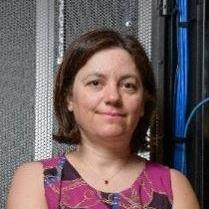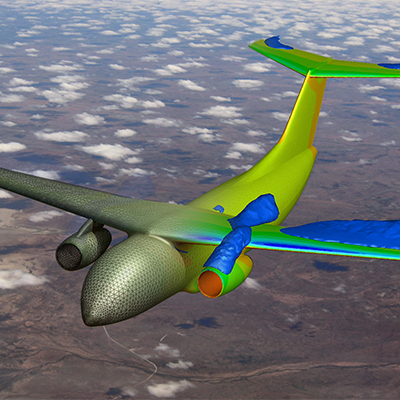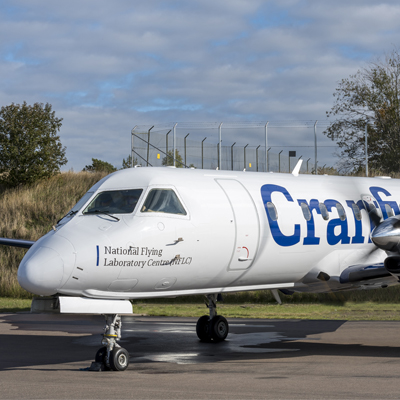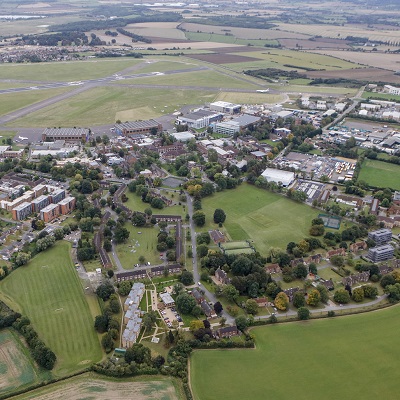Overview
- Start dateSeptember
- DurationFull-time: MSc - one year; Part-time: MSc - up to three years; Full-time PgCert - one year; Part-time PgCert - two years; Full-time PgDip - one year, Part-time PgDip - two years
- DeliveryTaught modules: 40%, group project: 20%, individual research project: 40%
- QualificationMSc, PgDip, PgCert
- Study typeFull-time / Part-time
- CampusCranfield campus
Who is it for?
This course is suitable for those with backgrounds in mathematics, physics, computer science or an engineering discipline. We also welcome applicants with relevant industrial experience such as qualified engineers working with computational methods wishing to extend their knowledge. The part-time option is suitable for qualified engineers looking to extend their knowledge and incorporate CFD into their skill set.
Why this course?
With its blend of skills-based and subject-specific material, this course aims to provide students with generic practical skills and cutting-edge knowledge adaptable to the wide variety of applications in the field of aerospace computational engineering. By undertaking this MSc, you will enhance your skills through a detailed introduction to the state-of-the-art computational methods and their applications for digital age aerospace engineering applications.
The course provides a unique opportunity for cross-disciplinary education and knowledge transfer in the computational engineering of fluid and solid mechanics for aerospace industrial applications. Focusing on fully integrated digital design for aerospace applications, you will be able to understand and implement numerical methods on various computing platforms for aerospace applications. As a graduate, you will meet the demand of an evolving workplace that requires highly qualified engineers possessing core software engineering skills together with competency in mathematical analysis techniques.
Sharing modules with the MSc in Computational Fluid Dynamics and the MSc in Computational and Software Techniques in Engineering, this course gives you the opportunity to interact with students from other disciplines.
Informed by industry
Our strategic links with industry ensure that all of the materials taught on the course are relevant, timely and meet the needs of organisations competing within the computational analysis sector. This industry-led education makes Cranfield graduates some of the most desirable for companies to recruit. Our industrial partners support this course by providing internships, acting as visiting lectures and delivering industrial seminars.
Course details
The taught modules are delivered from October to April via a combination of structured lectures, and computer-based labs. Many of the lectures are given in conjunction with some form of programming; you will be given time and practical assistance to develop your software skills.
Students on the part-time programme complete all of the compulsory modules based on a flexible schedule that will be agreed with the Course Director.
Course delivery
Taught modules: 40%, group project: 20%, individual research project: 40%
Group project
The group project is related to a wide range of aerospace applications, including a unique digital wind tunnel development. Projects are available for a) full-aircraft simulations and development of advanced turbulence models, b) structural analysis, c) fluid-structure interaction, d) coupling these aforementioned computational methods including an integrated digital design, e) advanced visualisation techniques, and f) the next generation of computational methods relevant to the aerospace industry.
Individual project
The taught element of the course finishes in May. From May to September you will work full-time on your individual research project. The research project gives you the opportunity to produce a detailed piece of work either in close collaboration with industry, or on a particular topic which you are passionate about.
Modules
Keeping our courses up-to-date and current requires constant innovation and change. The modules we offer reflect the needs of business and industry and the research interests of our staff and, as a result, may change or be withdrawn due to research developments, legislation changes or for a variety of other reasons. Changes may also be designed to improve the student learning experience or to respond to feedback from students, external examiners, accreditation bodies and industrial advisory panels.
To give you a taster, we have listed the compulsory and elective (where applicable) modules which are currently affiliated with this course. All modules are indicative only, and may be subject to change for your year of entry.
Course modules
Compulsory modules
All the modules in the following list need to be taken as part of this course.
C++ Programming
| Module Leader |
|
|---|---|
| Aim |
An introduction to the Python language is also provided. |
| Syllabus |
Functional programming in C++. |
| Intended learning outcomes |
On successful completion of this module you should be able to:
|
Computational Methods
| Aim |
|
|---|---|
| Syllabus |
The module explores numerical integration methods; the numerical solution of differential equations using finite difference approximations including formulation, accuracy and stability; matrices and types of linear systems, direct elimination methods, conditioning and stability of solutions, iterative methods for the solution of linear systems. Several of the studied numerical methods are implemented from scratch during the lab sessions, and the theoretical properties are then empirically studied and understood. |
| Intended learning outcomes |
On successful completion of this module you should be able to: 1. Formulate and assess numerical integration methods. 2. Use appropriate techniques to formulate numerical solutions to differential equations. 3. Evaluate properties of numerical methods, and choose the appropriate method to implement towards the solution of a given differential equation. 4. Evaluate properties of systems of linear equations, and choose the appropriate method to implement towards the solution of a given system of linear equations. 5. Assess the behaviour of the numerical methods and the computed numerical solutions. |
Computational Aerodynamics
| Aim |
Aerodynamics is of fundamental interest in computational aerospace science and engineering. It is taught as a standard undergraduate course on aerospace engineering courses. However, its complexity necessitates to approximate key aerodynamic coefficients through correlations and simplified theories; this is where this course comes into play. Computational Aerodynamics does not rely on simplified theories and instead employs Computational Fluid Dynamics (CFD) to solve the governing equations of fluid dynamics to replace these approximate theories and correlation-based tools, such as panel methods, lifting-line theory, or other potential flow-based methods. This provides a robust way to capture the linear lift slope regime with additional non-linear effects such as occurrences of laminar separation bubbles and stall. In a similar manner, drag values are no longer based on correlations but rather modelled through transport equations, providing greater accuracy. Coupling CFD with an introduction to Aerodynamics, this module provides the basis for calculating force and moment coefficients and essential flight mechanics stability analysis is reviewed where these force and moment coefficients play a dominant role. Along the way, classical and advanced concepts in Computational Fluid Dynamics are reviewed, from CAD clean-up and meshing to solving and post-processing, including the use of high-performance computing (HPC) facilities to allow for large aerodynamic calculations to be performed. |
|---|---|
| Syllabus |
|
| Intended learning outcomes |
On successful completion of this module you should be able to: 1. Develop a suitable cleaned CAD geometry and create a suitable volume mesh using commercial pre-processing software packages. 2. Perform aerodynamic simulations using Computational Fluid Dynamics (CFD) and appraise the different modelling techniques available to obtain aerodynamic coefficients, forces and moments and their computational cost / accuracy trade-off. 3. Use high-performance computing (HPC) resources to perform complex aerodynamic flow calculations, which includes setting up automated simulations through scripting to be run on HPC systems. 4. Calculate aerodynamic coefficients from raw CFD data and evaluate their differences to simplified aerodynamic correlations and mathematical theories from the literature. 5. Develop a simulation environment that is able to capture laminar / turbulent and incompressible / compressible flows, including an understanding of shock-wave capturing schemes. |
Validation and Verification for Aerospace Applications
| Aim |
|
|---|---|
| Syllabus |
|
| Intended learning outcomes |
On successful completion of this module you should be able to: 1. Distinguish and analyse different classes of numerical errors and uncertainties for simulating flows used in aeronautical and aerospace applications. 2. Evaluate the strength and weaknesses of computational approaches related to the potential sources of errors and uncertainties for aerospace applications. 3. Critically evaluate the tools that are available for the quantification of error and uncertainty for simulating external flows used in aeronautical and aerospace applications. 4. Set up reliable simulations through code verification and computational model validation. |
Modelling Approaches for Aerospace Applications
| Aim |
|
|---|---|
| Syllabus |
|
| Intended learning outcomes |
On successful completion of this module you should be able to: 1. Set up the governing equations of external fluid dynamics to simulate external flows in a digital wind tunnel. 2. Collect data with a systematic approach and analyse computational results through numerical methods and models for turbulent flows used in aeronautical and aerospace applications. 3. Evaluate the strength and limitations of computational methods used in the aerospace sector. 4. Propose solutions in conjunction with the current efforts made by industry and academia for improving the state-of-the-art methods in the above applications. |
Numerical Modelling for Compressible Flows
| Aim |
To introduce basic concepts in the discretisation and numerical solution of the hyperbolic systems of partial differential equations describing the flow of compressible fluids. |
|---|---|
| Syllabus |
|
| Intended learning outcomes |
On successful completion of this module you should be able to: 1. Demonstrate a critical awareness of the mathematical properties of hyperbolic partial differential equations. 2. Recognise the importance of non-linearities in the formation of shock waves. 3. Distinguish the fundamental differences between monotone schemes, WENO schemes for hyperbolic systems. 4. Judge the suitability of various Riemann solvers for various compressible flow problems. 5. Create high-resolution shock capturing schemes for compressible flow problems. |
Computational Engineering Structures
| Aim |
|
|---|---|
| Syllabus |
|
| Intended learning outcomes |
On successful completion of this module you should be able to: 1. Analyse and practice the theory of finite element models for structural and continuum elements. 2. Design and solve mathematical finite element models. 3. Interpret results of the FE simulations and analyse error levels. 4. Create and solve mathematical finite element methods. 5. Critically evaluate the constraints and implications imposed by the finite element method. |
CAD & Airframe Design
| Aim |
Each computational investigation requires a CAD model from which numerical analyses can be performed. This is true for both CFD and FEA simulations, both of which students are exposed to during their studies on this MSc. This module combines elements of CAD with an introduction to aerospace structures, focusing in particular on different components on the aircraft, as well as manufacturing philosophies which in turn inform the creation of parts (and CAD models). Students will learn how to build up various components of an aircraft using CATIA and OpenVSP as the CAD software and will be capable of designing components themselves, based on drawings and technical documents, which they can then use to study numerically the behaviour of the component. In addition, this module also explores elements of computational geometry, where students will work with and extend a simple Python-based CAD tool to generate parametric CAD components, which can be used in a parameterised computational workflow (e.g. for optimisation studies). Students will also work with CATIA's FEA and optimisation workbench, which can be used to construct and check structural components such as the wing, fuselage and empennage of an aircraft and optimise them to reduce weight and maximise stresses within the structure. |
|---|---|
| Syllabus |
|
| Intended learning outcomes |
On successful completion of this module you should be able to: 1. Create CAD models using commercial and industrial leading CAD software packages. 2. Design various components found on aeroplanes from drawings and technical documents. 3. Perform integrated Finite Element Analyses of structural components using Catia. 4. Perform optimisation of structural components to minimise weight of the final assembly using global optimisation methods. 5. Create parametric models that automatically update themselves based on external calculations. |
Teaching team
You will be taught by experienced academic staff from Cranfield University. Our staff are active researchers as well as tutors, with clients that include AWE, NASA Jet Propulsion Laboratory, European Space Research and Technology Centre (ESTEC), Jaguar Land Rover, BAE Systems, MBDA, MoD and SEA. Our teaching team work closely with business and have academic and industrial experience. Knowledge gained working with our clients is continually fed back into the teaching programme, to ensure that you benefit from the very latest knowledge and techniques affecting industry. The course also includes visiting lecturers from industry who will relate the theory to current best practice. Among these is Professor Guy Boy from Centrale Superlec.
The Course Director for this programme is Dr Tom Teschner.
Your career
The MSc in Aerospace Computational Engineering is designed to equip you with the skills required to pursue a successful career in computational aerospace design and engineering, both in the UK and globally.
Our courses attract enquiries from companies in the rapidly expanding aerospace computational and digital engineering industrial sector across the world who wish to recruit high quality graduates who have strong technical programming skills, and can assess and evaluate the results of digital/numerical simulations. They are in demand by CAD vendors, commercial engineering software developers, aerospace and computational science-related industrial sectors and research organisations, and have been particularly successful in finding employment.
Graduates of this course have gone into roles including:
- Aerospace Engineer
- Business Engineer
- CFD Application Engineer
- Computational Modelling Engineer
- Data Analyst
- Data Science Specialist
- Flight Operations Engineer
- Mechanical Engineer
- Pilot Officer
- Research and Development Project Manager
- Software Development Engineer
- Structural Engineer
- Technical Project Leader
- Test & Reliability Engineer
Companies that employ our graduates include:
- Airbus
- Capgemini Engineering
- Dassault Aviation
- easyJet
- Safran Engineering Services
- Thales
- Volvo Group
- Yodel
Some of our graduates go onto PhD degrees. Project topics are most often supplied by industrial companies offering unsolved engineering problems and purely academic-related research projects in the field of computational engineering are also available. Our graduates are highly employable after graduation in the wide range of industrial sector including R&D departments as well as academia. Our approach to a research degree is being actively sought by a growing number of industries and academic research institutions keen to expand their impact and innovation.
Cranfield’s Career Service is dedicated to helping you meet your career aspirations. You will have access to career coaching and advice, CV development, interview practice, access to hundreds of available jobs via our Symplicity platform and opportunities to meet recruiting employers at our careers fairs. Our strong reputation and links with potential employers provide you with outstanding opportunities to secure interesting jobs and develop successful careers. Support continues after graduation and as a Cranfield alumnus, you have free life-long access to a range of career resources to help you continue your education and enhance your career.
Part-time route
We welcome students looking to enhance their career prospects whilst continuing in full-time employment. The part-time study option that we offer is designed to provide a manageable balance that allows you to continue employment with minimal disruption whilst also benefiting from the full breadth of learning opportunities and facilities available to all students. The University is very well located for visiting part-time students from all over the world and offers a range of library and support facilities to support your studies.
As a part-time student you will be required to attend teaching on campus in one-week blocks, for a total of 8 blocks over the 3 year period that you are with us. Teaching blocks are typically run during the period from October to March, followed by independent study and project work where contact with your supervisors and cohort can take place in person or online.
We believe that this setup allows you to personally and professionally manage your time between work, study and family commitments, whilst also working towards achieving a Master's degree.
How to apply
Click on the ‘Apply now’ button below to start your online application.
See our Application guide for information on our application process and entry requirements.












